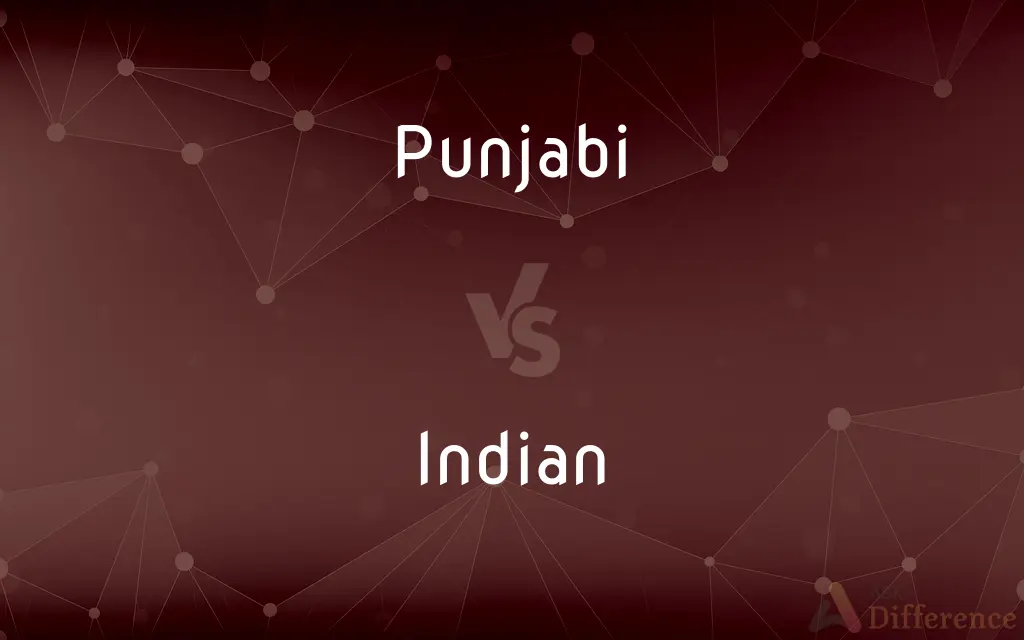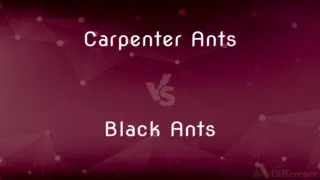Punjabi vs. Indian — What's the Difference?
Edited by Tayyaba Rehman — By Urooj Arif — Published on February 26, 2024
"Punjabi" refers to a cultural and linguistic group associated with the Punjab region, which is divided between India and Pakistan. "Indian" pertains to anything related to India, a diverse country with numerous ethnic groups, languages, and cultures.

Difference Between Punjabi and Indian
Table of Contents
ADVERTISEMENT
Key Differences
Punjabi culture is characterized by its rich traditions, vibrant music and dance forms like Bhangra and Giddha, distinctive cuisine featuring dishes like butter chicken and makki di roti with sarson da saag, and the Sikh religion, which has a significant presence in the region.
India's diversity encompasses a wide range of ethnicities, religions, languages, and cultures. It is home to major religions like Hinduism, Islam, Christianity, Sikhism, Buddhism, and Jainism. Indian culture is a tapestry of traditions, from the classical music and dance of the south to the folk traditions of the north.
The Punjabi language, written in the Gurmukhi script in India and Shahmukhi script in Pakistan, is integral to Punjabi identity. The country recognizes several languages, including Hindi and English as official languages, with 22 languages listed in the Eighth Schedule of the Indian Constitution, Punjabi being one of them.
Punjabi culture is part of the broader Indian mosaic, while it distinguishes itself through its language, religious practices (with Sikhism being predominantly followed in Punjab), and cultural specifics like attire, food, and festivals. India, as a nation, embraces this diversity, with each state and community contributing to the country's collective identity.
The distinction between "Punjabi" and "Indian" lies in specificity; Punjabi refers specifically to the cultural and linguistic attributes of the Punjab region and its people, while "Indian" encompasses the entire spectrum of cultures, languages, and ethnicities found within India's borders, including Punjabi.
ADVERTISEMENT
Comparison Chart
Geographical Origin
Punjab region, divided between India and Pakistan
Entire territory of India
Language
Punjabi
Multiple languages, including Hindi, English, Punjabi, Bengali, Telugu, and more
Religion
Predominantly Sikhism, along with Hinduism, Islam, and others
Diverse: Hinduism, Islam, Sikhism, Christianity, Buddhism, Jainism, etc.
Cuisine
Known for dishes like butter chicken, dal makhani, and parathas
Varies widely: includes Punjabi, South Indian, Gujarati, Bengali, and other regional cuisines
Music and Dance
Bhangra, Giddha
Diverse forms including Bharatanatyam, Kathak, Odissi, Bollywood, and more
Clothing
Salwar Kameez, Turban (especially among Sikhs)
Varied, including saree, salwar kameez, dhoti, lungi, and western attire
Festivals
Vaisakhi, Lohri
Diwali, Eid, Christmas, Navratri, Pongal, among many others
Cultural Identity
Distinct identity rooted in the Punjab region
Composite identity reflecting India's multicultural landscape
Compare with Definitions
Punjabi
Ethnic and cultural group.
The Punjabi community celebrated Vaisakhi with traditional fervor, showcasing their rich cultural heritage.
Indian
National identity.
Indians across the country celebrated Independence Day with patriotic zeal.
Punjabi
Regional cuisine.
Punjabi cuisine is renowned for its rich flavors and buttery dishes.
Indian
Diverse cultures.
Indian culture encompasses a wide range of traditions, languages, and religions.
Punjabi
Folk music and dance.
Bhangra, a lively Punjabi dance, is performed during many festive occasions.
Indian
Culinary diversity.
Indian cuisine varies from the spicy curries of the south to the tandoori dishes of the north.
Punjabi
Of or relating to the Punjab or the Punjabi language.
Indian
A person of Indian or East Indian ancestry.
Punjabi
An Indic language spoken in the Punjab.
Indian
One of the aboriginal inhabitants of America; - so called originally from the supposed identity of America with India.
Punjabi
A native or inhabitant of the Punjab.
Indian
A native or inhabitant of India or of the East Indies.
Indian
Of or relating to India or the East Indies or to their peoples, languages, or cultures.
Common Curiosities
Can Punjabi culture be found outside India?
Yes, Punjabi culture has a significant presence in countries like Canada, the United Kingdom, the United States, and Australia, due to the Punjabi diaspora.
What distinguishes Punjabi weddings from other Indian weddings?
Punjabi weddings are known for their lavish celebrations, vibrant dances like Bhangra, and specific rituals like the Mehndi ceremony. While sharing commonalities with other Indian weddings, they are distinguished by these vibrant traditions and extensive festivities.
Is Punjabi an official language in India?
Yes, Punjabi is one of the 22 officially recognized languages in the Indian Constitution, predominantly spoken in the state of Punjab.
How does Punjabi music contribute to Indian cinema?
Punjabi music, with its energetic beats and melodies, has heavily influenced Bollywood music, contributing to its popularity and appeal.
Are Punjabi and Indian cuisines significantly different?
Punjabi cuisine is a part of the broader Indian cuisine but is distinct for its rich, buttery flavors and extensive use of spices. It stands out for signature dishes like butter chicken and tandoori chicken, which have gained international fame, unlike other regional Indian cuisines that might emphasize seafood, vegetarian dishes, or rice-based meals.
How do Punjabi festivals integrate into the pan-Indian cultural landscape?
Punjabi festivals like Lohri and Vaisakhi are celebrated beyond Punjab, integrated into the Indian cultural landscape through the diaspora and shared cultural practices. These festivals highlight the agricultural calendar and Punjabi cultural heritage, resonating with broader themes of harvest and renewal found across Indian festivities.
How does the Punjabi language influence Indian literature?
Punjabi literature, with its rich heritage of poetry, folklore, and spiritual texts, particularly from Sikh traditions, contributes significantly to India's literary diversity. Figures like Guru Nanak and poets like Waris Shah and Bulleh Shah have left a lasting impact on Indian literature.
What is the significance of the Sikh religion in Punjab compared to its presence in the rest of India?
Sikhism, originating in Punjab in the 15th century, holds profound historical and cultural significance in the region, reflected in its festivals, daily life, and the revered Golden Temple in Amritsar. Across India, Sikhism is respected as one of the country's major religions, with Sikh communities contributing to Indian society in various fields, from agriculture to the armed forces.
How does the Punjabi education system compare to the broader Indian educational framework?
The Punjabi education system aligns with the national Indian educational framework but also emphasizes the Punjabi language, Sikh history, and regional culture within its curriculum. This regional focus aims to preserve Punjabi heritage while adhering to national educational standards and objectives.
What role does agriculture play in Punjabi culture compared to the rest of India?
Agriculture holds a central place in Punjabi culture, symbolized by the celebration of harvest festivals like Vaisakhi. Punjab, often called the "Granary of India," plays a crucial role in the nation's agricultural output, a prominence reflected in Punjabi songs, dances, and festivals celebrating farming life.
Are all Punjabis Sikh?
No, while Sikhism is prominent in Punjab, the region is home to people of various religious backgrounds, including Hindus, Muslims, Christians, and others.
How does the geographic location of Punjab influence its cultural exchanges with neighboring Indian states?
Punjab's geographical location, bordering states like Haryana, Rajasthan, and Himachal Pradesh, facilitates cultural exchanges that enrich its own traditions with influences from North Indian music, cuisine, and festivals. This cross-cultural interaction fosters a shared cultural heritage in the northern region of India, blending Punjabi traditions with those of its neighbors.
What impact have Punjabi immigrants had on the perception of Indian culture abroad?
Punjabi immigrants have significantly influenced the global perception of Indian culture through the spread of Punjabi music, cuisine, and religious practices. In countries with large Punjabi communities, elements of Punjabi culture, like Bhangra music and Sikh temples (Gurdwaras), have become integral to the multicultural tapestry, often representing Indian culture as a whole to international audiences.
How do traditional Punjabi attire and Indian fashion influence each other?
Traditional Punjabi attire, such as the salwar kameez for women and the turban for Sikh men, has influenced broader Indian fashion trends. The popularity of Punjabi suits and the adaptation of the turban style into Indian high fashion showcases a blend of regional attire into national trends, reflecting India's diverse cultural fabric.
In what ways do Punjabi and Indian cinema differ and overlap?
Punjabi cinema, or Pollywood, focuses on stories, music, and themes relevant to the Punjabi-speaking population, with a notable emphasis on comedy, drama, and the valorization of rural life. While Bollywood encompasses a wider range of languages and themes, including pan-Indian narratives, the two industries overlap through the incorporation of Punjabi music, actors, and cultural motifs into mainstream Indian cinema.
Share Your Discovery

Previous Comparison
Carpenter Ants vs. Black Ants
Next Comparison
QLED vs. Crystal UHDAuthor Spotlight
Written by
Urooj ArifUrooj is a skilled content writer at Ask Difference, known for her exceptional ability to simplify complex topics into engaging and informative content. With a passion for research and a flair for clear, concise writing, she consistently delivers articles that resonate with our diverse audience.
Edited by
Tayyaba RehmanTayyaba Rehman is a distinguished writer, currently serving as a primary contributor to askdifference.com. As a researcher in semantics and etymology, Tayyaba's passion for the complexity of languages and their distinctions has found a perfect home on the platform. Tayyaba delves into the intricacies of language, distinguishing between commonly confused words and phrases, thereby providing clarity for readers worldwide.
















































